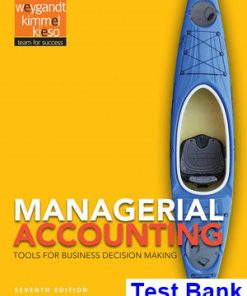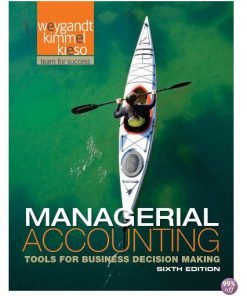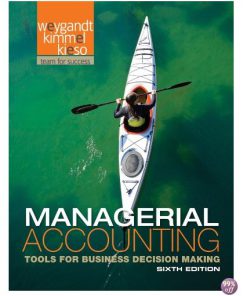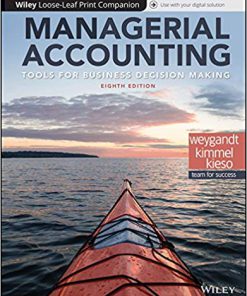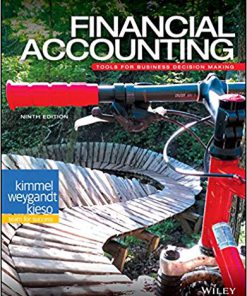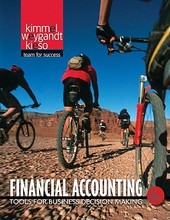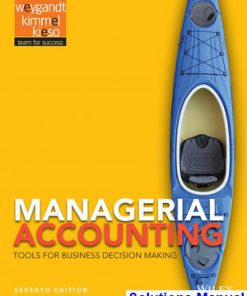Test Bank for Managerial Accounting Tools for Business Decision Making 8th Edition by Weygandt
$35.00 Original price was: $35.00.$26.50Current price is: $26.50.
Test Bank for Managerial Accounting Tools for Business Decision Making 8th Edition by Weygandt
This is completed downloadable of Test Bank for Managerial Accounting Tools for Business Decision Making 8th Edition by Weygandt
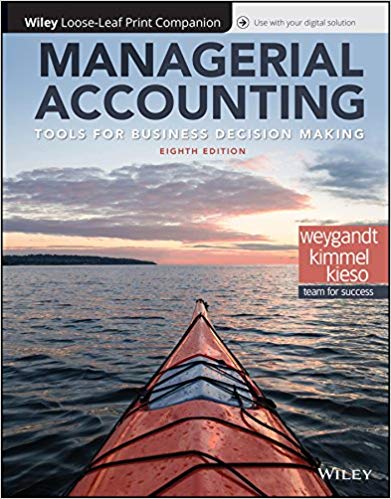
Product Details:
- ISBN-10 : 1119390389
- ISBN-13 : 978-1119390381
- Author: Jerry J. Weygandt (Author), Paul D. Kimmel (Author), Donald E. Kieso (Author)
Managerial Accounting provides students with a clear introduction to fundamental managerial accounting concepts. One of the major goals of this product is to orient students to the application of accounting principles and techniques in practice. By providing students with numerous opportunities for practice with a focus on real-world companies, students are better prepared as decision makers in the contemporary business world.
Table of Content:
- Chapter 1 Managerial Accounting
- 1.1 Just Add Water … and Paddle: Current Designs
- 1.2 Managerial Accounting Basics
- Comparing Managerial and Financial Accounting
- Management Functions
- Organizational Structure
- 1.3 Managerial Cost Concepts
- Manufacturing Costs
- Product Versus Period Costs
- Illustration of Cost Concepts
- 1.4 Manufacturing Costs in Financial Statements
- Income Statement
- Cost of Goods Manufactured
- Cost of Goods Manufactured Schedule
- Balance Sheet
- 1.5 Managerial Accounting Today
- Service Industries
- Focus on the Value Chain
- Balanced Scorecard
- Business Ethics
- Corporate Social Responsibility
- End-of-Chapter Homework
- Review and Practice
- Learning Objectives Review
- Decision Tools Review
- Glossary Review
- Practice Multiple-Choice Questions
- Practice Exercises
- Practice Problem
- WileyPlus
- Questions
- Brief Exercises
- DO IT! Exercises
- Exercises
- Problems: Set A
- Continuing Cases
- Current Designs
- Waterways
- Expand Your Critical Thinking
- Chapter 2 Job Order Costing
- 2.1 Profiting from the Silver Screen: Disney
- 2.2 Cost Accounting Systems
- Process Cost System
- Job Order Cost System
- Job Order Cost Flow
- Accumulating Manufacturing Costs
- 2.3 Assigning Manufacturing Costs
- Raw Materials Costs
- Factory Labor Costs
- 2.4 Predetermined Overhead Rates
- 2.5 Entries for Jobs Completed and Sold
- Assigning Costs to Finished Goods
- Assigning Costs to Cost of Goods Sold
- Summary of Job Order Cost Flows
- Job Order Costing for Service Companies
- Advantages and Disadvantages of Job Order Costing
- 2.6 Applied Manufacturing Overhead
- Under- or Overapplied Manufacturing Overhead
- End-of-Chapter Homework
- Review and Practice
- Learning Objectives Review
- Decision Tools Review
- Glossary Review
- Practice Multiple-Choice Questions
- Practice Exercises
- Practice Problem
- WileyPlus
- Questions
- Brief Exercises
- DO IT! Exercises
- Exercises
- Problems: Set A
- Continuing Cases
- Current Designs
- Waterways
- Comprehensive Case
- Expand Your Critical Thinking
- Chapter 3 Process Costing
- 3.1 The Little Guy Who Could: Jones Soda
- 3.2 Overview of Process Cost Systems
- Uses of Process Cost Systems
- Process Costing for Service Companies
- Similarities and Differences Between Job Order Cost and Process Cost Systems
- 3.3 Process Cost Flow and Assigning Costs
- Process Cost Flow
- Assigning Manufacturing Costs—Journal Entries
- 3.4 Equivalent Units
- Weighted-Average Method
- Refinements on the Weighted-Average Method
- 3.5 The Production Cost Report
- Compute the Physical Unit Flow (Step 1)
- Compute the Equivalent Units of Production (Step 2)
- Compute Unit Production Costs (Step 3)
- Prepare a Cost Reconciliation Schedule (Step 4)
- Preparing the Production Cost Report
- Costing Systems—Final Comments
- 3.6 Appendix 3A: FIFO Method for Computing Equivalent Units
- Equivalent Units Under FIFO
- Comprehensive Example
- FIFO and Weighted-Average
- End-of-Chapter Homework
- Review and Practice
- Learning Objectives Review
- Decision Tools Review
- Glossary Review
- Practice Multiple-Choice Questions
- Practice Exercises
- Practice Problem
- WileyPlus
- Questions
- Brief Exercises
- DO IT! Exercises
- Exercises
- Problems: Set A
- Continuing Cases
- Current Designs
- Waterways
- Expand Your Critical Thinking
- Chapter 4 Activity-Based Costing
- 4.1 Precor Is on Your Side: Precor
- 4.2 Traditional vs. Activity-Based Costing
- Traditional Costing Systems
- Illustration of a Traditional Costing System
- The Need for a New Approach
- Activity-Based Costing
- 4.3 ABC and Manufacturers
- Identify and Classify Activities and Allocate Overhead to Cost Pools (Step 1)
- Identify Cost Drivers (Step 2)
- Compute Activity-Based Overhead Rates (Step 3)
- Assign Overhead Costs to Products (Step 4)
- Comparing Unit Costs
- 4.4 ABC Benefits and Limitations
- The Advantage of Multiple Cost Pools
- The Advantage of Enhanced Cost Control
- The Advantage of Better Management Decisions
- Some Limitations and Knowing When to Use ABC
- 4.5 ABC and Service Industries
- Traditional Costing Example
- Activity-Based Costing Example
- 4.6 Appendix 4A: Just-in-Time Processing
- Objective of JIT Processing
- Elements of JIT Processing
- Benefits of JIT Processing
- End-of-Chapter Homework
- Review and Practice
- Learning Objectives Review
- Decision Tools Review
- Glossary Review
- Practice Multiple-Choice Questions
- Practice Exercises
- Practice Problem
- WileyPlus
- Questions
- Brief Exercises
- DO IT! Exercises
- Exercises
- Problems: Set A
- Continuing Cases
- Current Designs
- Waterways
- Comprehensive Case
- Expand Your Critical Thinking
- Chapter 5 Cost-Volume-Profit
- 5.1 Don’t Worry—Just Get Big: Amazon.com
- 5.2 Cost Behavior Analysis
- Variable Costs
- Fixed Costs
- Relevant Range
- Mixed Costs
- 5.3 Mixed Costs Analysis
- High-Low Method
- Importance of Identifying Variable and Fixed Costs
- 5.4 Cost-Volume-Profit Analysis
- Basic Components
- CVP Income Statement
- 5.5 Break-Even Analysis
- Mathematical Equation
- Contribution Margin Technique
- Graphic Presentation
- 5.6 Target Net Income and Margin of Safety
- Target Net Income
- Margin of Safety
- 5.7 Appendix 5A: Regression Analysis
- End-of-Chapter Homework
- Review and Practice
- Learning Objectives Review
- Decision Tools Review
- Glossary Review
- Practice Multiple-Choice Questions
- Practice Exercises
- Practice Problem
- WileyPlus
- Questions
- Brief Exercises
- DO IT! Exercises
- Exercises
- Problems: Set A
- Continuing Problems
- Current Designs
- Waterways
- Expand Your Critical Thinking
- Chapter 6 Cost-Volume-Profit Analysis: Additional Issues
- 6.1 Not Even a Flood Could Stop It: Whole Foods Market
- 6.2 Basic CVP Concepts
- Basic Concepts
- Basic Computations
- CVP and Changes in the Business Environment
- 6.3 Sales Mix and Break-Even Sales
- Break-Even Sales in Units
- Break-Even Sales in Dollars
- 6.4 Sales Mix with Limited Resources
- 6.5 Operating Leverage and Profitability
- Effect on Contribution Margin Ratio
- Effect on Break-Even Point
- Effect on Margin of Safety Ratio
- Operating Leverage
- 6.6 Appendix 6A: Absorption Costing vs. Variable Costing
- Example Comparing Absorption Costing with Variable Costing
- Net Income Effects
- Decision-Making Concerns
- Potential Advantages of Variable Costing
- End-of-Chapter Homework
- Review and Practice
- Learning Objectives Review
- Decision Tools Review
- Glossary Review
- Practice Multiple-Choice Questions
- Practice Exercises
- Practice Problem
- WileyPlus
- Questions
- Brief Exercises
- DO IT! Exercises
- Exercises
- Problems: Set A
- Continuing Cases
- Current Designs
- Waterways
- Expand Your Critical Thinking
- Chapter 7 Incremental Analysis
- 7.1 Keeping It Clean: Method Products
- 7.2 Decision-Making and Incremental Analysis
- Incremental Analysis Approach
- How Incremental Analysis Works
- Qualitative Factors
- Relationship of Incremental Analysis and Activity-Based Costing
- Types of Incremental Analysis
- 7.3 Special Orders
- 7.4 Make or Buy
- Opportunity Cost
- 7.5 Sell or Process Further
- Single-Product Case
- Multiple-Product Case
- 7.6 Repair, Retain, or Replace Equipment
- 7.7 Eliminate Unprofitable Segment or Product
- End-of-Chapter Homework
- Review and Practice
- Learning Objectives Review
- Decision Tools Review
- Glossary Review
- Practice Multiple-Choice Questions
- Practice Exercises
- Practice Problem
- WileyPlus
- Questions
- Brief Exercises
- DO IT! Exercises
- Exercises
- Problems: Set A
- Continuing Cases
- Current Designs
- Waterways
- Expand Your Critical Thinking
- Chapter 8 Pricing
- 8.1 They’ve Got Your Size—and Color: Zappos.com
- 8.2 Target Costing
- Establishing a Target Cost
- 8.3 Cost-Plus and Variable-Cost Pricing
- Cost-Plus Pricing
- Limitations of Cost-Plus Pricing
- Variable-Cost Pricing
- 8.4 Time-and-Material Pricing
- 8.5 Transfer Prices
- Negotiated Transfer Prices
- Cost-Based Transfer Prices
- Market-Based Transfer Prices
- Effect of Outsourcing on Transfer Pricing
- Transfers Between Divisions in Different Countries
- 8.6 Appendix 8A: Absorption-Cost and Variable-Cost Pricing
- Absorption-Cost Pricing
- Variable-Cost Pricing
- 8.7 Appendix 8B: Transfers Between Divisions in Different Countries
- End-of-Chapter Homework
- Review and Practice
- Learning Objectives Review
- Decision Tools Review
- Glossary Review
- Practice Multiple-Choice Questions
- Practice Exercises
- Practice Problem
- WileyPlus
- Questions
- Brief Exercises
- DO IT! Exercises
- Exercises
- Problems: Set A
- Continuing Cases
- Current Designs
- Waterways
- Comprehensive Case
- Expand Your Critical Thinking
- Chapter 9 Budgetary Planning
- 9.1 What’s in Your Cupcake?: BabyCakes NYC
- 9.2 Effective Budgeting and the Master Budget
- Budgeting and Accounting
- The Benefits of Budgeting
- Essentials of Effective Budgeting
- The Master Budget
- 9.3 Sales, Production, and Direct Materials Budgets
- Sales Budget
- Production Budget
- Direct Materials Budget
- 9.4 Direct Labor, Manufacturing Overhead, and S&A Expense Budgets
- Direct Labor Budget
- Manufacturing Overhead Budget
- Selling and Administrative Expense Budget
- Budgeted Income Statement
- 9.5 Cash Budget and Budgeted Balance Sheet
- Cash Budget
- Budgeted Balance Sheet
- 9.6 Budgeting in Nonmanufacturing Companies
- Merchandisers
- Service Companies
- Not-for-Profit Organizations
- End-of-Chapter Homework
- Review and Practice
- Learning Objectives Review
- Decision Tools Review
- Glossary Review
- Practice Multiple-Choice Questions
- Practice Exercises
- Practice Problem
- WileyPlus
- Questions
- Brief Exercises
- DO IT! Exercises
- Exercises
- Problems: Set A
- Continuing Cases
- Current Designs
- Waterways
- Comprehensive Case
- Expand Your Critical Thinking
- Chapter 10 Budgetary Control and Responsibility Accounting
- 10.1 Pumpkin Madeleines and a Movie: Tribeca Grand Hotel
- 10.2 Budgetary Control and Static Budget Reports
- Budgetary Control
- Static Budget Reports
- 10.3 Flexible Budget Reports
- Why Flexible Budgets?
- Developing the Flexible Budget
- Flexible Budget—A Case Study
- Flexible Budget Reports
- 10.4 Responsibility Accounting and Responsibility Centers
- Controllable versus Noncontrollable Revenues and Costs
- Principles of Performance Evaluation
- Responsibility Reporting System
- Types of Responsibility Centers
- 10.5 Investment Centers
- Return on Investment (ROI)
- Responsibility Report
- Judgmental Factors in ROI
- Improving ROI
- 10.6 Appendix 10A: ROI vs. Residual Income
- Residual Income Compared to ROI
- Residual Income Weakness
- End-of-Chapter Homework
- Review and Practice
- Learning Objectives Review
- Decision Tools Review
- Glossary Review
- Practice Multiple-Choice Questions
- Practice Exercises
- Practice Problem
- WileyPlus
- Questions
- Brief Exercises
- DO IT! Exercises
- Exercises
- Problems: Set A
- Continuing Problems
- Current Designs
- Waterways
- Expand Your Critical Thinking
- Chapter 11 Standard Costs and Balanced Scorecard
- 11.1 80,000 Different Caffeinated Combinations: Starbucks
- 11.2 Overview of Standard Costs
- Distinguishing Between Standards and Budgets
- Setting Standard Costs
- 11.3 Direct Materials Variances
- Analyzing and Reporting Variances
- Calculating Direct Materials Variances
- 11.4 Direct Labor and Manufacturing Overhead Variances
- Direct Labor Variances
- Manufacturing Overhead Variances
- 11.5 Variance Reports and Balanced Scorecards
- Reporting Variances
- Income Statement Presentation of Variances
- Balanced Scorecard
- 11.6 Appendix 11A: Standard Cost Accounting System
- Journal Entries
- Ledger Accounts
- 11.7 Appendix 11B: Overhead Controllable and Volume Variances
- Overhead Controllable Variance
- Overhead Volume Variance
- End-of-Chapter Homework
- Review and Practice
- Learning Objectives Review
- Decision Tools Review
- Glossary Review
- Practice Multiple-Choice Questions
- Practice Exercises
- Practice Problem
- WileyPlus
- Questions
- Brief Exercises
- DO IT! Exercises
- Exercises
- Problems: Set A
- Continuing Cases
- Current Designs
- Waterways
- Expand Your Critical Thinking
- Chapter 12 Planning for Capital Investments
- 12.1 Floating Hotels: Holland America Line
- 12.2 Capital Budgeting and Cash Payback
- Cash Flow Information
- Illustrative Data
- Cash Payback
- 12.3 Net Present Value Method
- Equal Annual Cash Flows
- Unequal Annual Cash Flows
- Choosing a Discount Rate
- Simplifying Assumptions
- Comprehensive Example
- 12.4 Capital Budgeting Challenges and Refinements
- Intangible Benefits
- Profitability Index for Mutually Exclusive Projects
- Risk Analysis
- Post-Audit of Investment Projects
- 12.5 Internal Rate of Return
- Comparing Discounted Cash Flow Methods
- 12.6 Annual Rate of Return
- End-of-Chapter Homework
- Review and Practice
- Learning Objectives Review
- Decision Tools Review
- Glossary Review
- Practice Multiple-Choice Questions
- Practice Exercises
- Practice Problem
- WileyPlus
- Questions
- Brief Exercises
- DO IT! Exercises
- Exercises
- Problems: Set A
- Continuing Cases
- Current Designs
- Waterways
- Comprehensive Case
- Expand Your Critical Thinking
- Chapter 13 Statement of Cash Flows
- 13.1 Got Cash?: Microsoft
- 13.2 Usefulness and Format of the Statement of Cash Flows
- Usefulness of the Statement of Cash Flows
- Classification of Cash Flows
- Significant Noncash Activities
- Format of the Statement of Cash Flows
- 13.3 Preparing the Statement of Cash Flows—Indirect Method
- Indirect and Direct Methods
- Indirect Method—Computer Services Company
- Step 1: Operating Activities
- Summary of Conversion to Net Cash Provided by Operating Activities—Indirect Method
- Step 2: Investing and Financing Activities
- Step 3: Net Change in Cash
- 13.4 Analyzing the Statement of Cash Flows
- Free Cash Flow
- 13.5 Appendix 13A: Statement of Cash Flows—Direct Method
- Step 1: Operating Activities
- Step 2: Investing and Financing Activities
- Step 3: Net Change in Cash
- 13.6 Appendix 13B: Worksheet for the Indirect Method
- Preparing the Worksheet
- 13.7 Appendix 13C: Statement of Cash Flows—T-Account Approach
- End-of-Chapter Homework
- Review and Practice
- Learning Objectives Review
- Decision Tools Review
- Glossary Review
- Practice Multiple-Choice Questions
- Practice Exercises
- Practice Problem
- WileyPlus
- Questions
- Brief Exercises
- DO IT! Exercises
- Exercises
- Problems: Set A
- Continuing Cases
- Waterways
- Expand Your Critical Thinking
- Chapter 14 Financial Analysis: The Big Picture
- 14.1 It Pays to Be Patient: Warren Buffett
- 14.2 Sustainable Income and Quality of Earnings
- Sustainable Income
- Quality of Earnings
- 14.3 Horizontal Analysis and Vertical Analysis
- Horizontal Analysis
- Vertical Analysis
- 14.4 Ratio Analysis
- Liquidity Ratios
- Solvency Ratios
- Profitability Ratios
- Comprehensive Example of Ratio Analysis
- End-of-Chapter Homework
- Review and Practice
- Learning Objectives Review
- Decision Tools Review
- Glossary Review
- Practice Multiple-Choice Questions
- Practice Exercises
- Practice Problem
- WileyPlus
- Questions
- Brief Exercises
- DO IT! Exercises
- Exercises
- Problems: Set A
- Continuing Cases
- Waterways
- Expand Your Critical Thinking
- Appendix A Time Value of Money
- A.1 Interest and Future Values
- Nature of Interest
- Future Value of a Single Amount
- Future Value of an Annuity
- A.2 Present Values
- Present Value Variables
- Present Value of a Single Amount
- Present Value of an Annuity
- Time Periods and Discounting
- Present Value of a Long-Term Note or Bond
- A.3 Capital Budgeting Situations
- A.4 Using Financial Calculators
- Present Value of a Single Sum
- Present Value of an Annuity
- Future Value of a Single Sum
- Future Value of an Annuity
- Internal Rate of Return
- Useful Applications of the Financial Calculator
- Cases for Managerial Decision-Making
- Company Index
- Subject Index
- Alternate Chapter 2 Job Order Costing
- 2A.1 Profiting from the Silver Screen: Disney
- 2A.2 Cost Accounting Systems
- Process Cost System
- Job Order Cost System
- Job Order Cost Flow
- Accumulating Manufacturing Costs
- 2A.3 Assigning Manufacturing Costs
- Raw Materials Costs
- Factory Labor Costs
- 2A.4 Predetermined Overhead Rates
- 2A.5 Jobs Completed and Sold
- Assigning Costs to Finished Goods
- Assigning Costs to Cost of Goods Sold
- Summary of Job Order Cost Flows
- Job Order Costing for Service Companies
- Advantages and Disadvantages of Job Order Costing
- 2A.6 Applied Manufacturing Overhead
- Under- or Overapplied Manufacturing Overhead
- End-of-Chapter Homework
- Review and Practice
- Learning Objectives Review
- Decision Tools Review
- Glossary Review
- Practice Multiple-Choice Questions
- Practice Exercises
- Practice Problem
- WileyPlus
- Questions
- Brief Exercises
- DO IT! Exercises
- Exercises
- Problems: Set A
- Continuing Cases
- Current Designs
- Waterways
- Comprehensive Case
- Expand Your Critical Thinking
- Alternate Chapter 3 Process Costing
- The Little Guy Who Could: Jones Soda
- Overview of Process Cost Systems
- Uses of Process Cost Systems
- Process Costing for Service Companies
- Similarities and Differences Between Job Order Cost and Process Cost Systems
- 3A.1 Process Cost Flow and Assigning Costs
- Process Cost Flow
- Assigning Manufacturing Costs
- 3A.2 Equivalent Units
- Weighted-Average Method
- Refinements on the Weighted-Average Method
- 3A.3 The Production Cost Report
- Compute the Physical Unit Flow (Step 1)
- Compute the Equivalent Units of Production (Step 2)
- Compute Unit Production Costs (Step 3)
- Prepare a Cost Reconciliation Schedule (Step 4)
- Preparing the Production Cost Report
- Costing Systems—Final Comments
- 3A.4 Appendix 3A: FIFO Method for Computing Equivalent Units
- Equivalent Units Under FIFO
- Comprehensive Example
- FIFO and Weighted-Average
- End-of-Chapter Homework
- Review and Practice
- Learning Objectives Review
- Decision Tools Review
- Glossary Review
- Practice Multiple-Choice Questions
- Practice Exercises
- Practice Problem
- WileyPlus
- Questions
- Brief Exercises
- DO IT! Exercises
- Exercises
- Problems: Set A
- Continuing Cases
- Current Designs
- Waterways
- Expand Your Critical Thinking
- EULA
People Also Search:
managerial accounting tools for business decision making 8th
managerial accounting tools for business decision making 8th edition pdf
managerial accounting tools for business decision making 8th edition solutions
You may also like…
Solution Manual
Solution manual for Accounting: Tools for Business Decision Making Kimmel Weygandt Kieso 5th Edition
Test Bank
Test Bank for Managerial Accounting Tools for Business Decision Making 6th Edition by Weygandt
Solution Manual
Solution Manual for Managerial Accounting Tools for Business Decision Making 6th Edition by Weygandt
Solution Manual
Solution Manual for Managerial Accounting Tools for Business Decision Making 8th Edition by Weygandt
Solution Manual
Solution Manual
Managerial Accounting Tools for Business Decision Making 7th Edition Weygandt Solutions Manual




